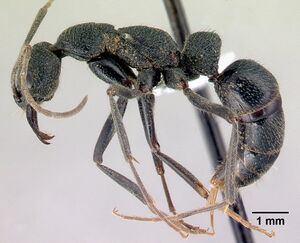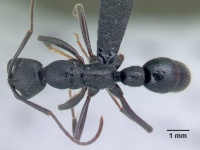Leptogenys pilaka
| Leptogenys pilaka | |
|---|---|

| |
| Scientific classification | |
| Kingdom: | Animalia |
| Phylum: | Arthropoda |
| Class: | Insecta |
| Order: | Hymenoptera |
| Family: | Formicidae |
| Subfamily: | Ponerinae |
| Tribe: | Ponerini |
| Genus: | Leptogenys |
| Species group: | incisa |
| Species complex: | alluaudi |
| Species: | L. pilaka |
| Binomial name | |
| Leptogenys pilaka Rakotonirina & Fisher, 2014 | |
Worker specimens were found foraging on the forest floor, and the colony nests were located in the rotten logs.
Identification
A member of the alluaudi complex of the incisa species group. Rakotonirina and Fisher (2014) - Worker. Small, peg-like setae absent from near anteromedian margin of clypeus, above anteriorly fringing semi-translucent lamella; in full-face view, eye extending beyond lateral cephalic margin; head short (CI: 94–97); antennal scape relatively short; mandible narrow, inner margin not convex and slightly curved near bases; blades mostly smooth with faint longitudinal striation.
Leptogenys pilaka is very similar to Leptogenys incisa andLeptogenys alluaudi, but is separable from L. alluaudi by the location of its eyes, which split the lateral outline of the head. In L. alluaudi, the eyes do not break the lateral cephalic margin. The species can be separated from L. incisa by its broader head and by the narrower mandibular blades which are not strongly curved at the base and have a largely smooth and shiny surface.
Keys including this Species
Distribution
Latitudinal Distribution Pattern
Latitudinal Range: -12.9089° to -12.9089°.
| North Temperate |
North Subtropical |
Tropical | South Subtropical |
South Temperate |
- Source: AntMaps
Distribution based on Regional Taxon Lists
Malagasy Region: Madagascar (type locality).
Distribution based on AntMaps
Distribution based on AntWeb specimens
Check data from AntWeb
Countries Occupied
| Number of countries occupied by this species based on AntWiki Regional Taxon Lists. In general, fewer countries occupied indicates a narrower range, while more countries indicates a more widespread species. |

|
Estimated Abundance
| Relative abundance based on number of AntMaps records per species (this species within the purple bar). Fewer records (to the left) indicates a less abundant/encountered species while more records (to the right) indicates more abundant/encountered species. |

|
Habitat
Leptogenys pilaka occurs in northern Madagascar, in the transitional forest of the RS Ankarana at 80 m and in the lower montane rainforest of PN Montagne d’Ambre at 885 m.
Biology
|
Castes
Worker
Images from AntWeb
   
| |
| Holotype of Leptogenys pilaka. Worker. Specimen code casent0428200. Photographer Jean Claude Rakotonirina, uploaded by California Academy of Sciences. | Owned by CAS, San Francisco, CA, USA. |
Nomenclature
The following information is derived from Barry Bolton's Online Catalogue of the Ants of the World.
- pilaka. Leptogenys pilaka Rakotonirina & Fisher, 2014: 95, figs. 46B, 47B, 106, 122 (w.) MADAGASCAR.
Unless otherwise noted the text for the remainder of this section is reported from the publication that includes the original description.
Description
Worker
(5 specimens). HW: 1.98–2.17, HL: 2.09–2.23, CI: 94–97, SL: 2.38–2.52, SI: 116–123, PW: 1.37–1.47, WL: 3.45–3.66, PNH: 1.14–1.22, PNL: 1.04–1.11, PNW: 0.97–1.09, DNI: 90–99, LNI: 106–112.
Head more or less elongate and broader anteriorly than posteriorly; lateral border weakly convex and diverging from back to front. Eye large, jutting from head surface and splitting lateral cephalic margin. Antennal scape relatively short. Lateral margin of clypeus convex and rounding to short, narrowly triangular anteromedian lobe; edge of clypeus fringed with narrow and obtusely angulate semi-translucent lamella. Mandible long and slender, weakly curved near base; inner margin concave; apical portions not strongly intersecting and not closing tightly against clypeus. Hypostomal teeth not visible when head in full-face view. In lateral view, mesosoma relatively high and short; with bluntly angulate junction between propodeal dorsum and declivity; propodeal lobe with blunt angle. In dorsal view, mesosoma with three visible segments, metanotal groove impressed. Constriction between third and fourth abdominal segments fairly visible. Mandibles are mostly smooth and shining, though sparse and short striation may be present. Dorsum of head finely longitudinally rugulose from front to level of anterior margin of eye, becoming densely and finely reticulate-rugose toward mid-length of head, rest of head dorsum with fine microreticulate rugulae superimposed with large and shallow elongate punctures. Anterior portion of pronotum finely microreticulate, superimposed with coarse punctures; rest of mesosomal dorsum and petiolar node microreticulate, overlaid by a mixture of fine and coarse transverse rugae and shallow, large elongate punctures. Declivitous surface transversely rugose. Third abdominal tergite with elongate small punctures. Standing hairs present, pubescence abundant on head dorsum but very sparse on rest of body dorsum. Coloration black, basal portion of appendages brown, apical portion and tip of gaster light brown.
Type Material
Holotype worker: Madagascar, Antsiranana, RS Ankarana, 22.9 km 224° SW Anivorano Nord, -12.9089, 49.1098, 80 m, tropical dry forest, ex rotten log, 10–16 Feb 2001 (Fisher, Griswold et al.) collection code: BLF02867, specimen code: CASENT0428200 (California Academy of Sciences). Paratypes: 4 workers with same data as holotype but with the following specimen codes: CASENT0428201, CASENT0428202, CASENT0428116, CASENT0247223 (CASC, The Natural History Museum, Parc Botanique et Zoologique de Tsimbazaza).
References
- Rakotonirina, J.C. & Fisher, B.L. 2014. Revision of the Malagasy ponerine ants of the genus Leptogenys Roger (Hymenoptera: Formicidae). Zootaxa 3836, 1-163.
References based on Global Ant Biodiversity Informatics
- Rakotonirina J. C., and B. L. Fisher. 2014. Revision of the Malagasy ponerine ants of the genus Leptogenys Roger (Hymenoptera: Formicidae). Zootaxa 3836 (1): 001163.

